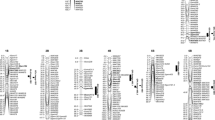Abstract
An intervarietal molecular-marker map was used for the detection of genomic regions influencing crossability between wheat (Triticum aestivum L. em Thell) and rye (Secale cereale L.). Analysis of deviance and logistic marker-regression methods were conducted on data from doubled haploid lines from a cross between “Courtot” and “Chinese Spring”. A major quantitative trait locus (QTL) involved in crossability, associated with the marker Xfba367-5B, was detected on the short arm of chromosome 5B. An additional locus, Xwg583-5B, was indicated on the long arm of chromosome 5B. This minor QTL might correspond to Kr1 which was presumed to be the major gene controlling crossability. Another locus of the genome, Xtam51-7A on chromosome 7A, was significantly associated with this trait. Alleles of “non-crossability” were contributed by the non-crossable cultivar “Courtot”. The three-marker model explains 65% of the difference in crossability between the two parents. The present results are discussed in relation to those previously carried out to locate the Kr genes by using the telocentric mapping technique.
Similar content being viewed by others
Author information
Authors and Affiliations
Additional information
Received: 27 February 1998 / Accepted: 15 May 1998
Rights and permissions
About this article
Cite this article
Tixier, M., Sourdille, P., Charmet, G. et al. Detection of QTLs for crossability in wheat using a doubled-haploid population. Theor Appl Genet 97, 1076–1082 (1998). https://doi.org/10.1007/s001220050994
Issue Date:
DOI: https://doi.org/10.1007/s001220050994




